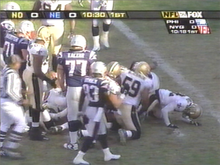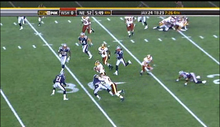- NFL on Fox
-
NFL on Fox 
Logo used since the 2003 NFL seasonFormat Sports Starring Fox NFL Sunday crew
NFL on Fox game commentatorsCountry of origin United States Production Location(s) NFL stadiums
Fox Network Center, Los Angeles (studio)Running time 180 minutes or until game ends Production company(s) National Football League
Fox SportsBroadcast Original channel Fox Picture format 480i downconverted letterboxed widescreen (SDTV),
720p (HDTV)Original run September 4, 1994 – present External links Website NFL on Fox is the brand name of the Fox Broadcasting Company's coverage of the National Football League's National Football Conference games, produced by Fox Sports. Game coverage is usually preceded by the pre-game show Fox NFL Sunday and followed by The OT, a postgame show with the Fox NFL Sunday hosts,[1] between the end of the last game and the start of prime time programming.
Contents
Theme music
The broadcast's distinctive theme music has been used since its inception in 1994. Derivatives of the NFL on Fox theme have been incorporated throughout Fox Sports' programming, including Fox Sports Net, as Fox Sports' overall theme, and Fox registered the original theme as a U.S. trademark in 2006.[2] The theme was produced by Scott Schreer through his production company NJJ Music. The theme was composed by Scott Schreer, Reed Hays and Phil Garrod. When there is an injury timeout on the playing field, Fox generally cuts to commercial using a remix where a piano replaces the horns section while playing the main theme.[3]
In October 2010, the NFL on Fox theme was implemented on all Fox Sports properties, including baseball. It was first implemented on the network's baseball broadcasts beginning with the 2010 National League Championship Series and then was implemented on its NASCAR broadcasts in 2011. As a result of Fox using its NFL theme during the 2010 MLB playoffs, there has been some backlash from fans who preferred to hear the theme that Fox used for MLB in the past. A poll by Sports Media Watch noted that as of October 23, 2010, while nearly 60% of fans thought that Fox made a bad move, only 10% thought it was a good move and 30% had no opinion (all percentages rounded).[4] Four Facebook pages have been also created as a result of this change, A campaign has been started to bring the MLB theme back to Fox baseball broadcasts.[5] Another one has been started as well to bring the original NASCAR theme (the one used from 2001–2007) back to Fox NASCAR coverage.[6] A FB page called "The Fox Sports Theme Music Restoration Project" has also been launched,[7] while the other group has been started to remove Eric Shanks (who is responsible for this decision) as President of Fox Sports.[8]
History
Though Fox was growing rapidly as a network, and had established itself as a presence, it was still not considered a major competitor to the "big three" broadcast networks (ABC, CBS, and NBC). Fox management, having seen the critical role that soccer programming had played in the growth of British satellite service BSkyB, believed that sports, and specifically professional football, would be the engine that would make Fox a major network the quickest.
Early bids
To this end, Fox bid aggressively for football from the start. In 1987 (Fox's first full year on the air), after ABC initially hedged on renewing its contract to carry Monday Night Football,[9][10] Fox offered the NFL to pick up the contract[11] for the same amount ABC had been paying,[12][13] about $1.3 billion at the time. However, the NFL, in part because Fox had not established itself as a major network,[14] chose to renew their contract with ABC.
Meanwhile, after the Fox Television Network was launched, United States Football League founder David Dixon proposed the "American Football Federation", which would have 10 teams and draft academically ineligible high school graduates.[15]
Despite a few successful shows, the network did not have a significant market share until the early 1990s when News Corp. bought more TV station groups, such as New World Communications and Chris-Craft Industries' BHC Communications and United Television, making it the largest owner of television stations in the United States. The time now filled by the NFL on Fox on Sunday afternoons was formerly in the control of the stations themselves, who usually filled them with either weekend syndicated series or Sunday afternoon movie blocks.
Fox outbids CBS for the NFC package
Six years later, when the football contract was up for renewal again, Fox made what at the time, was a bold and aggressive move to acquire the rights. Knowing that they would likely need to bid considerably more than the incumbent networks to acquire a piece of the package, Fox bid $1.58 billion for four years of rights to the NFC, exceeding CBS' bid by more than $100 million a year. The NFC was considered the more desirable conference (as opposed to the AFC package that NBC carried at the time) due to its presence in most of the largest U.S. markets, such as New York, Chicago, and Philadelphia. To the surprise and shock of many, in late 1993, the NFL selected the Fox bid, in the process stripping CBS of football for the first time since 1956. Fox's coverage would start in the 1994 season.
CBS apparently underestimated the value of its rights with respect to its advertising revenues and to its promotional opportunities for other network programming. Indeed, Fox was still an upstart player in 1993, not yet considered on par with the "Big Three" networks--CBS, NBC and ABC. It had already had offbeat hits such as The Simpsons, Married...With Children and Beverly Hills, 90210, but had no news or sports divisions, and its coverage was significantly weaker than that of its elder counterparts.
CBS personalities move to Fox
However, the vast resources of Rupert Murdoch allowed the network to grow quickly, primarily to the detriment of CBS. After bringing in David Hill from Murdoch's U.K.-based Sky Sports to head-up the new Fox Sports division, Fox raided the CBS Sports staff, hiring longtime producer Ed Goren as Hill's second-in-command, plus CBS personalities such as Pat Summerall, John Madden, James Brown, Terry Bradshaw, Matt Millen, and Dick Stockton, all of whom were prominently featured in Fox's NFL coverage.
In spring 1994, Fox's parent News Corporation struck an alliance with New World Communications, by now a key ownership group with several VHF CBS affiliates in NFC markets, and wary of a CBS without football. Nearly all of New World's stations converted en masse to Fox beginning that fall. The rights gave Fox many new viewers (and affiliates) and a platform for advertising its other shows.
See also: Fox affiliate switches of 1994A brand new era
Fox's acquisition of football was a watershed event not only for the network but for the NFL as well. Not only was it the event that placed Fox on a par with the "big three" broadcast networks (ABC, CBS, and NBC) but it also ushered in an era of growth for the NFL which continues on largely to this day.
While the heavy concentration of population in NFC markets – as opposed to the smaller markets generally served by the AFC – virtually guaranteed a substantial audience, its instant success has nonetheless been remarkable given the substantial differences between Fox's coverage and the coverage provided by ABC, CBS, ESPN, TNT, and NBC up to that time.
"Same Game, New Attitude"
Fox's launch slogan was "Same Game, New Attitude." Indeed, its studio show focused more on entertainment and less on in-depth discussion of X's and O's. It also introduced bolder and innovative graphics, for instance, a continuous on-screen time-and-score graphic that Hill had originally used on Sky Sports's coverage of the Premier League. Fox also used parabolic microphones to include the sounds of the stands and of the on-field action. These innovations were quickly adopted by rival networks and helped to drive the development of further innovations such as the virtual first-down line.
Post-game show: The OT
In 2005, the NFL on Fox decided to name its post-game show The OT and expand it to the full hour before 8pm ET/7pm CT in order to remove the possibility of ratings damage to new episodes and series in that slot which traditionally were pre-empted by games most every week to viewer frustration for fans of those programs and to keep the remainder of Fox's Sunday night schedule on track to allow Fox's local stations to start their primetime newscasts on time (expendable reruns of Fox's animated series air in other equivalent time zones). In part, this was done as an in-joke to promote Fox's Thursday soap The O.C., which began its third season in September 2005. That program ended in May 2007; however The OT has been retained as the post-game show title to the present day. The program usually goes to fill the full hour, which provides some form of competition to NBC's Football Night in America.
Changes for 2006
After the 2005 season, James Brown left Fox to return to CBS Sports, where he would be the host of The NFL Today. On August 16, 2006, after weeks of speculation, the network officially announced that Joe Buck would take over the role. The move also changed the show from a permanent Los Angeles studio into a portable studio configuration, similar to the pregame show for NASCAR on Fox, where analysts Terry Bradshaw, Howie Long, and Jimmy Johnson joined Buck at the game to which Buck is assigned as play-by-play announcer. Curt Menefee worked all halftime shows and all postgame shows on non-doubleheader Sundays, also from the same game site with the same analysts. Menefee hosted Fox NFL Sunday during the several weeks in October when Buck was not available; during that time, Buck called Major League Baseball postseason games, including the World Series. The October 15, 22 and 29 shows were broadcast from the Los Angeles studios; the show returned to the road on November 5.
It was also announced that weather reporter Jillian Barberie (now Jillian Reynolds) would not return for the coming season, as Barberie wished to stay at home in Los Angeles with her family.[16] Barberie did participate in at least one of the studio shows.
During the 2006 season, Chris Rose provided updated highlights during the game from the Los Angeles studio as a voice talent.
On November 17, 2006, a source told the Los Angeles Times that the final two pregame shows of 2006 would take place in the Los Angeles studios, with Buck hosting and Dick Stockton taking Buck's place at the games alongside Troy Aikman. The source cited that declining ratings no longer justified its high production costs, including security expenses. A Fox spokesman would only say that changes were being considered.[17]
2006 playoffs controversies
Main article: NFL playoffs, 2006-07The Fox Broadcasting Company came under fire[18] by the Parents Television Council for showing a New Orleans Saints fan wearing a shirt reading "F**K DA EAGLES" in Saints colors. Three days after the broadcast, the network apologized. The Saints fan, Heather Rothstein, was contacted by Maxim magazine and was given a photo shoot.[19]
Also during the 2006 NFC Championship between the Chicago Bears and the New Orleans Saints at Soldier Field, in one shot from the overhead camera angle of the crowd, three Bears fans were seen giving a middle finger gesture towards the field.
Changes for 2007
After the 2006 NFL season, Fox NFL Sunday returned to the Los Angeles studio throughout the entire 2007 regular season and for the 2 weeks of that year's postseason. Curt Menefee became the full-time host of the pregame show, while Joe Buck reverted to play-by-play only.
2010 Monday night special
Fox presented a limited Monday night game between the New York Giants and Minnesota Vikings on December 13, 2010, which was only made available to the main markets of both teams (on WNYW in New York, Albany's WXXA-TV, KMSP in the Twin Cities, Rochester's KXLT and in Duluth, KQDS-TV). The game had been originally scheduled to be played on the afternoon on December 12, but due to the collapse of the roof of the Metrodome due to a heavy snow event early that morning, the game was moved on short notice to Ford Field in Detroit as that facility already had their full television setup still in place after a Packers/Lions game. Fox Sports had kept their cameras on in the Metrodome overnight the night before the original date of the game and captured the roof collapse in full detail; the video of multiple angles of the early morning collapse was aired on that morning's Fox NFL Sunday and quickly went viral.
Coincidentally, this was the first game since 1992 that Brett Favre did not start an NFL game, as he was made inactive due to a shoulder injury, ending his streak of 297 consecutive regular season games; Tavaris Jackson started in his place. In addition, it was the first ever regular-season Monday night game in Ford Field.
Digital on-screen graphics
Main article: FoxBox (sports)In its debut in the 1994 season, Fox's coverage featured the first "scoring bug." A transparent white half-capsule-shaped graphic in the upper left corner of the screen displayed the score and game clock throughout the entire telecast, an NFL first.
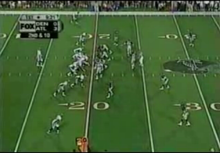 A version of the score bug used in Super Bowl XXXIII and 1998 to 2000.
A version of the score bug used in Super Bowl XXXIII and 1998 to 2000.
1996–2000
By 1996, the graphic changed to a full-statistics panel, where down and distance, penalty, and key in-game statistics would pop in and out when necessary. It was named the "FOX BOX", and its basic design mimicked the "FOX BOX" used in Fox's MLB coverage. For Fox's coverage of Super Bowl XXXIII at the end of the 1998 season, the starting lines ups were shown using a virtual TV. To TV viewers, it appeared as if the end zone opened up and a giant TV came up out of the ground. The virtual TV displayed video announcing the starting line ups. The virtual TV effect was provided by PVI Virtual Media Services using their L-VIS virtual graphics system.
2001–2002
In 2001, Fox implemented a new graphics package for NFL telecasts, an updated version of the 1998 design, but the graphic changed from a bug to a banner spanning the top of the screen, and included a scrolling graphic displaying real-time scores of other games in progress. A simple black rectangle with a shaded transparent area spanned the top of the screen from left to right, displaying the abbreviations of both teams in white. The scores would be shown in white boxes next to the team. The center showed the game clock in white, to its right was the quarter ("1st QTR", "2nd QTR", etc.), and to the right of the quarter was the play clock. The far right was the NFL on Fox logo. For the 2002 season, the white scoring boxes where changed to yellow. This was first seen during Super Bowl XXXVI. This was also the last year that a team's initials would flash in its two primary colors along with percussive sound beats when that team scored (for example, when the Green Bay Packers scored a touchdown on Fox, the "GB" initials and box would flash in green and gold for a few seconds as the six points for the TD were added, then again with the extra point). This banner was used for Major League Baseball on Fox broadcasts through most of the 2004 season.
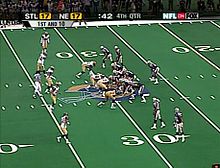 The score banner used in Super Bowl XXXVI and 2002.
The score banner used in Super Bowl XXXVI and 2002.
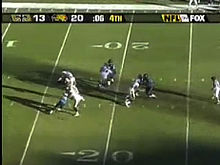 The score banner used in 2003. (this screencap is taken at the start of the River City Relay play)
The score banner used in 2003. (this screencap is taken at the start of the River City Relay play)
2003–2005
The banner was given a cosmetic upgrade beginning with the 2003 season. Instead of a large black rectangle, the banner alternated between a large back rectangle and several small, black parallelograms, and the shaded area above it was removed. Instead of abbreviations for the teams, their logos were now used. During the 2003 NFL playoffs, the logos were reduced in size, and the team abbreviations were put back beside them. The banner returned to a large black rectangle at the start of the 2004 season. with the team logos looking more "3-dimensional", and electronic lettering in the team's main color was used whenever that certain team calls timeout, scores a touchdown, or a field goal. It would be in red whenever the team challenges a play. Also during a touchdown or field goal, the right side of the banner would have a split flashing "light", then the words "TOUCHDOWN or FIELD GOAL" and the team's name in electronic lettering moving left. Midway through 2004, the team logos were replaced with the abbreviations. This time, they were electronic lettering in the team's main color, and this was first seen on Major League Baseball on Fox postseason broadcasts that year. When team-specific information was displayed in the banner, such as the hang time of a punt or a touchdown, the abbreviation would change back to the team's logo. During the 2005 holiday season, for the week 15 Saturday game (Tampa Bay at New England), a new white banner, resembling a chrome finish and first introduced at the start of Fox's coverage of the 2005 World Series, debuted with animated snow accumulating on top. Periodically an animated snowplow would clear the screen of snow. The following week, the new banner was adopted for all games, however without the snow animation. The team abbreviations became white letters against the team's main color. This banner was used for Major League Baseball on Fox broadcasts through the 2007 season.
2006–2009
The newest iteration of the scoring banner for the 2006 season features the real-time scores as a permanent fixture on the extreme right side of the bar, while the coloring of the banner changes to the colors of the team currently possessing the ball.
During playoff games and games featured on special days or holidays (such as the Thanksgiving Classic, AFC vs. NFC game), the scoring bar instead shows either the NFL Thanksgiving Classic logo, the NFL Divisional Playoffs/NFC Championship logo, or a special banner celebrating whichever holiday falls during that week from Fox Sports (for instance, confetti and a party horn with a traditional Happy New Year message).
At the beginning of the 2006 season, a virtual on-field graphic showing an arrow pointing towards the direction of advancement and the down/yardage information began to be used on all plays. This feature was then added by the NFL on CBS, NBC Sunday Night Football, NFL Network's Run to the Playoffs and (beginning with the 2008 season) ESPN's Monday Night Football broadcasts. At the same time, the down/yardage information also displays on the scoring banner, resulting in duplicate presentation of the same information. The bar has also been enhanced for HDTV and is thinner than previous versions, with little transparency. Also, the NFL on Fox logo is on the far left instead of the far right. On the HDTV broadcasts, the area above the banner features a translucent slanting pattern going from left-to-right across the screen. During the 2006 preseason telecasts, the quarter was indicated by illuminating four buttons (number of buttons lit indicated the quarter), but due to visibility difficulties, the quarter returned to being numerically represented for the regular season.
On rare occasion during a game in which the field lines are not visible (such as those dealing with snow or rain), a small bug pops up on the bottom left side of the screen with the logo of the team who currently has possession as well as text indicating where the ball is (e.g. Arizona-Own 41 Yard Line.)
Most recently, scores from other NFL games that appear on the right side of the banner would have an arrow indicating which team had the ball, as of November 15, 2009. When the arrow is red, it means that the team is at the redzone. Fox's NFL telecasts were the only major NFL telecasts to have no timeout indicators until the 2010 season (see "2010-present" below for more), save for the number of timeouts that each team has on the right side of the banner.
December 31, 2006 San Francisco/Denver game
There was one exception to this package for the 2006 season, as Fox had to revert to the then-current Fox Sports Net (and former main Fox Sports) scoring banner and graphics package for its final regular season game of the year, San Francisco 49ers at Denver Broncos on December 31, 2006, due to a second blizzard in a week hitting Denver, preventing the usual amount of equipment for Fox's NFL coverage to arrive before the game. FSN Rocky Mountain (Denver's FSN network) assisted in the production of the game on short notice by providing the graphical production and other production services. Also, the "1st & Ten" graphic lines denoting the line of scrimmage and first down line were unavailable for this broadcast. This graphic was also used in Week 5 of the 2007 season in a game between the Arizona Cardinals and St. Louis Rams.
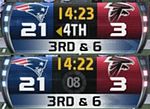 The 2010 iteration of the scorebox, showing the timing and play clock modes for the graphic. The down bar displays an arrow pointing to the team that has possession of the ball (along with denoting any thrown flags), while a throbber in the play clock example ticks down the seconds (the play clock apprears when it's down to ten seconds, and turns red in the last five seconds) until the expiration of time. The play clock (seen in the middle of the scoring bug) was moved to below the team in possession of the ball, starting with Week 1 of the 2010 NFL regular season.
The 2010 iteration of the scorebox, showing the timing and play clock modes for the graphic. The down bar displays an arrow pointing to the team that has possession of the ball (along with denoting any thrown flags), while a throbber in the play clock example ticks down the seconds (the play clock apprears when it's down to ten seconds, and turns red in the last five seconds) until the expiration of time. The play clock (seen in the middle of the scoring bug) was moved to below the team in possession of the ball, starting with Week 1 of the 2010 NFL regular season.
2010-present
Fox's new graphics package for NFL games debuted during a pre-season game on August 19, 2010, as Fox began to broadcast their sports programming with graphics optimized for 16:9 displays rather than the 4:3 safe area and the network has asked cable and satellite providers to comply and use the #10 Active Format Description code they now send out over Fox programming, which has 16:9 content display in letterboxed mode on 4:3 screens (or to most viewers, the regular analog channel on their system), in concert with Fox's news operations also going to full widescreen presentation.[20] This was promoted in that first game by the Fox broadcast team as giving a 'widescreen viewing experience' to standard definition viewers, using the usual examples of more video information on the screen to demonstrate the new presentation (such as two cheerleaders off to the side displayed in a widescreen shot, but cut out of a 4:3 shot) [21]
The graphics package is an updated version of the 2006 design, but utilizing a score box to the left side of the screen featuring team logos, with timeout indicators 'lighting' along each side of the box and the middle portion being used to relay time/quarter and scoring information, along with a play clock indicator with only ten seconds before a snap must be made (which also appears within the on-field graphic). The Fox Sports logo is displayed on the right side of the screen and displays in-progress scores for other NFL and MLB games to its left, or an NFL event or playoff logo.
The new graphics package was adjusted more to fit in at the edge of the 4:3 frame after the pre-season games as many cable providers were unable to meet the Week One deadline of widescreen presentation on Fox's analog 4:3 channels. By Week 5 on October 11 however, most of the providers had complied with the AFD #10 edict in time for the 2010 NLCS starting the following Saturday, along with Fox's few low power analog television stations and secondary digital subchannel affiliates, and Fox began to present all graphics on one game per week to fit the 16:9 frame. This means for those cable systems yet to convert their Fox affiliate to 4:3 widescreen and during highlights packages seen on ESPN and NFL Network and local television and newscasts visual, textual and graphical information is compromised (only the home half of the score and a small bit of the clock is seen in the 4:3 frame), or the highlights will be presented in an undesired form of windowboxing for 16:9/HD viewers who are watching a news operation which has not converted to high definition. Fox provides an alternate feed to the other networks (CBS, NBC, NFL Redzone) with the score box fitting the 4:3 frame for use in halftime shows and updates, and some games (mainly in markets with heavy translator station and digital subchannel presences) are still presented with graphics optimized for 4:3.
During Week 15 and 16, the top of the score box was covered with snow (with snowflakes falling on top of it) and the timeout indicators were changed to resemble strings of Christmas lights in observance of the holiday season. When the score box animated away before a commercial break, the snow would fall off the box down through the bottom of the screen.
All other Fox Sports properties, including Speed, Fox Sports Net, and Fox Soccer, would also begin to phase in variants of this design throughout 2011. These graphics would also be adopted for Fox's college football coverage beginning with the 2011 Cotton Bowl Classic. However, NFL coverage remains the only variant of the package to exclusively use team logos on the scorebar, as all other variants (including college football) use only written team locations or initials.
Tweaks were made for the 2011 season, including the timeout indicators counting upward instead of downward, and scores from other games being moved to a ticker at the bottom of the screen instead of next to the Fox Sports logo. Also, the possession marker has been moved to appear along side the team that currently has the ball.
Ratings
The NFL on Fox booth at Candlestick Park during a game on November 16, 2008. Matt Vasgersian and J.C. Pearson are calling the game.
Fox NFL Sunday had been the ratings leader among network pregame coverage from the time of its debut in 1994 (as, at the time, it was the only network pregame show to air for one hour prior to kickoff). In 2006, however, CBS' The NFL Today overtook the Fox pregame in the ratings. The swing in ratings was said to be correlated with the move of Fox NFL Sunday host James Brown back to CBS, where he had been broadcasting before his jump to Fox in 1994.[22]
Fox's 2008 telecast of Super Bowl XLII was the 2nd most watched Super Bowl (Giants vs. Patriots) in history, with 97.5 million viewers.[23] It was also the second-most-watched TV program behind the 1983 M*A*S*H series finale.[23] Coincidentally, the Phoenix area hosted Super Bowl XXX (which aired on NBC), the third most viewed Super Bowl in NFL history, with 95.1 million viewers, in 1996.
With an average US audience of 111 million viewers, Super Bowl XLV became the most-watched Super Bowl as well as the most-watched progam of any kind in American television history, beating the previous record of 106.5 million viewers for Super Bowl XLIV. An estimated 162.9 million total viewers watched all or part of the game.[24] The game drew a national household Nielsen rating of 46.0 and a 69 share. It drew a 59.7 local rating in both Milwaukee and Pittsburgh, the second-highest local rating for a Super Bowl after the 63.0 that Super Bowl XX drew in Chicago. In the host market of Dallas-Ft. Worth, the game drew a 53.7 rating.[25]
Commentators
In-studio personalities
Main article: Fox_NFL_Sunday#Full_list_of_on-air_staffIn-game commentators (past & present)
Further information: List of NFL on Fox announcers and List of NFL on Fox commentator pairingsReferences
- ^ Retrieved on 2009-08-13. The OT on Fox TV Guide
- ^ TARR status for trademark serial no. 78590770, USPTO. Retrieved 2010-12-16.
- ^ A version of this remix plays in this clip of an NFL on Fox broadcast from 0:24–0:34.
- ^ Sports Media Watch poll on change of Fox theme Retrieved 2010-10-23
- ^ "Bring back the MLB on Fox theme music" Facebook Page
- ^ "Bring back the Nascar on Fox theme music" Facebook Page
- ^ "The Fox Sports Theme Music Restoration Project" Facebook Page
- ^ "Fire Eric Shanks as President of Fox Sports" Facebook Page
- ^ BUDGET AX STALKS MONDAY NIGHT FOOTBALL
- ^ FOX'S AMBITIOUS PLANS A BIG DEAL
- ^ The Decline and Fall of Monday Night Football
- ^ Fox Network Wants the NFL
- ^ SECOND LOOK THE TELEVISION NETWORKS: COPING WITH
- ^ 2 NEW FOX SERIES-PLAINLY NO VANILLA
- ^ "New spring football league seeks TV deal," Pacific Stars and Stripes, January 11, 1965, p. 25
- ^ Hiestand, Michael (August 16, 2006). "PGA on the web: Something for office workers". USA Today. http://www.usatoday.com/sports/columnist/hiestand-tv/2006-08-16-hiestand-pga_x.htm. Retrieved 2009-07-31.
- ^ Stewart, Larry (November 17, 2006). "Whoa, Nellie, it doesn't get any bigger than this". Los Angeles Times. http://www.latimes.com/sports/custom/extras/la-sp-tvcol17nov17,1,6350453.column?page=2&coll=la-sports-extras. Retrieved 2009-07-31.[dead link]
- ^ Parents Television Council – Because Our Children Are Watching
- ^ F-ck Da Eagles Heather Photos
- ^ Transition to Widescreen Milwaukee HDTV
- ^ Fox Sports taking a wider view of football Milwaukee Journal Sentinel
- ^ Sports Couch Potato: Pregame power shift
- ^ a b de Moraes, Lisa (February 5, 2008). "Super Bowl's Big Score: 97.5 Million Viewers". The Washington Post. http://www.washingtonpost.com/wp-dyn/content/article/2008/02/04/AR2008020401109.html?hpid=sec-nation. Retrieved 2009-07-31.
- ^ Seidman, Robert (2011-02-07). "Super Bowl XLV Breaks Viewing Record, Averages 111 Million Viewers". tvbythenumbers.com. http://tvbythenumbers.zap2it.com/2011/02/07/super-bowl-xlv-poised-to-break-viewing-records-ties-1987-with-highest-overnight-ratings-ever/81684.
- ^ "Fox Draws 47.9 Overnight Rating For Super Bowl XLV, Tied For Highest Ever". Sports Business Daily. 2011-02-07. http://www.sportsbusinessdaily.com/Daily/Issues/2011/02/Feb-7/Media/Super-Bowl-Fox-game.aspx.
External links
- Fox brought TV to new level
- FoxSports.com NFL Sunday announces new host
- FoxSports.com – NFL on Foxsports.com
- Who is the Host?
- NFL on Fox at the Internet Movie Database
- Sports Media Watch: NFL on Fox
- Fang's Bites - Fox Sports
Links to related articles Preceded by
CBSNFC
broadcaster
1994 – PresentSucceeded by
IncumbentNFL on Fox Related programs Related articles Commentators American Bowl · Bills Toronto Series · Christmas games · Commentator pairings · International Series · NFC Championship Game · Pro Bowl · Super Bowl · Thanksgiving Classic · World BowlLore Music Super Bowl Pro Bowl 2008 · 2011World Bowl Fox Sports Current programs NFL on Fox • Major League Baseball on Fox • NASCAR on Fox • Fox College Football • Cotton Bowl Classic • Formula One • Soccer Night in AmericaAmerican cable/satellite networks Big Ten Network (49 %) • Fox College Sports • Fox Soccer • Fox Soccer Plus • Fox Sports Net • Fox Deportes • Fuel TV • SpeedOwned and operated
regional sports networksArizona • Detroit • Florida / Sun Sports • Houston • Midwest / Indiana / Kansas City • North / Wisconsin • Ohio • South / Carolinas / Tennessee / SportSouth • Southwest / Oklahoma • West / Prime TicketAffiliated regional sports networks Root Sports (Northwest, Pittsburgh, Rocky Mountain / Utah) • Comcast SportsNet (Bay Area, Chicago, New England, Philadelphia, and Washington) • MSG Network • MSG PlusInternational sports networks Others Former programs Defunct networks Fox NFL Sunday team Studio Supporting cast Former Fox Sports • NFL on Fox • Fox NFL SundayNational Football League on television and radio Television broadcast partners Monday Night Football ResultsSunday Night Football ResultsESPN • TNT • NBCPregame television programs NFL Network List of programs • Thursday Night Football (Results (2006–present))NFL Films television programs NFL Films Game of the Week • NFL's Greatest Games • Hard Knocks • Inside the NFL • NFL Matchup • Football Follies • Full Color FootballOther television programs Radio broadcast partners CBS/Westwood One • Compass Media • ESPN • Mutual • NBC • Sports USA
Secondary radio broadcast partnersLocal radio networksBuffalo Bills Radio Network • Dallas Cowboys Radio Network • Detroit Lions Radio Network • Green Bay Packers Radio Network • List of Minnesota Vikings broadcasters • New England Patriots Radio Network • New York Giants Radio NetworkBroadcasters by event AFC Championship Game · AFL Championship Game · AFL All-Star Game · American Bowl · Bills Toronto Series · Christmas games · Hall of Fame Game · International Series · NFC Championship Game · NFL Championship Game · NFL Draft · NFL Kickoff Game · Playoff Bowl · Pro Bowl · Super Bowl · Thanksgiving Classic · World Bowl
Television broadcast technology Other television information Blackout (broadcasting) • Canadian broadcasts • Doubleheader (television) • Fox affiliate switches of 1994 • List of major sports teams in the United States by city • Primary television stations • Sports Broadcasting Act of 1961
NFL on DuMont Related programs Football Sidelines · Football This Week · Pro Football HighlightsRelated articles NFL on television · Surviving broadcasts
New York GiantsPittsburgh SteelersPhiladelphia Eagles1955Washington RedskinsCommentators NFL Championship Pro Bowl 1954Fox Network programming (current & upcoming) Current Allen Gregory (since 2011) · American Dad! (since 2005) · American Idol (since 2002) · Bob's Burgers (since 2011) · Bones (since 2005) · Breaking In (since 2011) · Buried Treasure (since 2011) · The Cleveland Show (since 2009) · COPS (since 1989) · Family Guy (since 1999–2002; 2005) · Fox News Sunday (since 1996) · Fox College Football (since 1999) · Fringe (since 2008) · Glee (since 2009) · Hell's Kitchen (since 2005) · House (since 2004) · Kitchen Nightmares (since 2007) · Major League Baseball on Fox (since 1996) · MasterChef (since 2010) · Mobbed (since 2011) · NASCAR on Fox (since 2001) · New Girl (since 2011) · NFL on Fox/Fox NFL Sunday (since 1994) · Raising Hope (since 2010) · The Simpsons (since 1989) · So You Think You Can Dance (since 2005) · Terra Nova (since 2011) · The X Factor (since 2011)Upcoming Alcatraz (Midseason) · I Hate My Teenage Daughter (November 30, 2011) · The Finder (2012) · Napoleon Dynamite (Midseason) · Touch (2012)- Complete Fox List
- (current & upcoming)
See also: 4Kids TV · Fox Kids · Speed on Fox · Weekend Marketplace- ABC (current)
- AMC
- CBS (current)
- CW
- E!
- Fox
- FX
- HBO
- OWN
- NBC (current)
- Showtime
- Starz
- TBS
- TNT
- USA
Categories:- Fox network shows
- National Football League television series
- 1990s American television series
- 2000s American television series
- 2010s American television series
- Fox Sports
- 1994 American television series debuts
Wikimedia Foundation. 2010.


